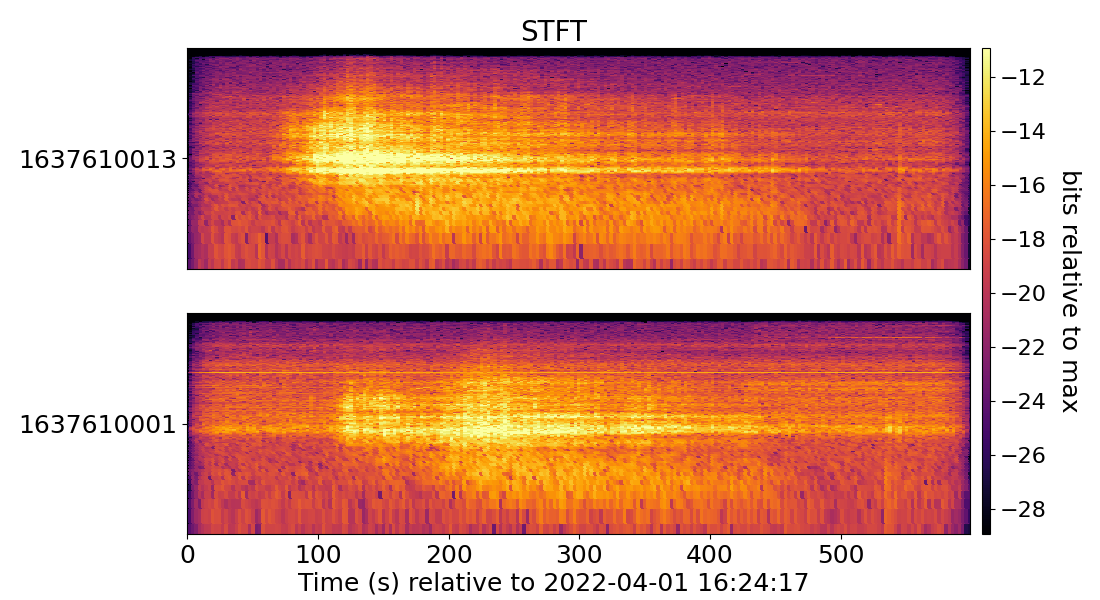Plot Audio Spectrogram#
In this example we will plot the audio spectrogram using RedPandas. The steps are very similar to the previous example where we plotted the audio waveforms.
Running the example#
The first step is to load RedVox data into a DataWindow.
from redvox.common.data_window import DataWindow
# Input Directory
input_dir = "path/to/redvox/data/dw_1648830257000498_2.pkl.lz4"
# Load data window from report
dw = DataWindow.deserialize(input_dir)
The next step is to make a pandas dataframe using RedPandas redpd_dataframe.
from redvox.common.data_window import DataWindow
from redpandas.redpd_df import redpd_dataframe
# Input Directory
input_dir = "path/to/redvox/data/dw_1648830257000498_2.pkl.lz4"
# Load data window from report
dw = DataWindow.deserialize(input_dir)
# Make a pandas DataFrame, where crucial information from DataWindow is extracted
# In this case, we are only extracting 'audio' from the DataWindow but other sensors such as 'barometer',
# 'accelerometer', 'gyroscope', 'magnetometer', 'health', or 'location' are possible
rp_df = redpd_dataframe(input_dw=dw,
sensor_labels=['audio'])
Calculate the Short-term Fourier transform using tfr_bits_panda.
from redvox.common.data_window import DataWindow
from redpandas.redpd_df import redpd_dataframe
from redpandas.redpd_tfr import tfr_bits_panda
# Input Directory
input_dir = "path/to/redvox/data/dw_1648830257000498_2.pkl.lz4"
# Load data window from report
dw = DataWindow.deserialize(input_dir)
# Make a pandas DataFrame, where crucial information from DataWindow is extracted
# In this case, we are only extracting 'audio' from the DataWindow but other sensors such as 'barometer',
# 'accelerometer', 'gyroscope', 'magnetometer', 'health', or 'location' are possible
rp_df = redpd_dataframe(input_dw=dw,
sensor_labels=['audio'])
# Calculate time frequency representation (TFR)
tfr_bits_panda(df=rp_df, # the name of the redpandas dataframe, in this case rp_df
sig_wf_label="audio_wf", # Column label with sensor data, in this case audio
sig_sample_rate_label="audio_sample_rate_nominal_hz", # Column label with sample rate
order_number_input=12, # Optional, default=3
tfr_type="stft") # Optional, 'stft' or 'cwt, default='stft'
# tfr_bits_panda will make 3 new columns with the time frequency representation: 'tfr_bits', 'tfr_time_s',
# 'tfr_frequency_hz'. Double check they are strored in the dataframe
print(f'Check for "tfr_bits", "tfr_time_s", "tfr_frequency_hz":\n{rp_df.columns.values}')
Let’s plot the spectrogram with plot_mesh_pandas .
from redvox.common.data_window import DataWindow
from redpandas.redpd_df import redpd_dataframe
from redpandas.redpd_tfr import tfr_bits_panda
from redpandas.redpd_plot.mesh import plot_mesh_pandas
import matplotlib.pyplot as plt
# Input Directory
input_dir = "path/to/redvox/data/dw_1648830257000498_2.pkl.lz4"
# Load data window from report
dw = DataWindow.deserialize(input_dir)
# Make a pandas DataFrame, where crucial information from DataWindow is extracted
# In this case, we are only extracting 'audio' from the DataWindow but other sensors such as 'barometer',
# 'accelerometer', 'gyroscope', 'magnetometer', 'health', or 'location' are possible
rp_df = redpd_dataframe(input_dw=dw,
sensor_labels=['audio'])
# Calculate time frequency representation (TFR)
tfr_bits_panda(df=rp_df, # the name of the redpandas dataframe, in this case rp_df
sig_wf_label="audio_wf", # Column label with sensor data, in this case audio
sig_sample_rate_label="audio_sample_rate_nominal_hz", # Column label with sample rate
order_number_input=12, # Optional, default=3
tfr_type="stft") # Optional, 'stft' or 'cwt, default='stft'
# tfr_bits_panda will make 3 new columns with the time frequency representation: 'tfr_bits', 'tfr_time_s',
# 'tfr_frequency_hz'. Double check they are strored in the dataframe
print(f'Check for "tfr_bits", "tfr_time_s", "tfr_frequency_hz":\n{rp_df.columns.values}')
# Plot spectrogram
plot_mesh_pandas(df=rp_df,
mesh_time_label="tfr_time_s", # Column label for TFR timestamps
mesh_frequency_label="tfr_frequency_hz", # Column label for TFR frequency
mesh_tfr_label="tfr_bits", # Column label for TFR bits
t0_sig_epoch_s=rp_df["audio_epoch_s"][0][0], # The first timestamp
sig_id_label="station_id", # Column name with IDs/names of stations, important for y ticks
frequency_hz_ymin=1.,
frequency_hz_ymax=200.,
frequency_scaling='log',
ytick_values_show=True, # show y ticks for frequency
common_colorbar=True, # add colorbar
)
plt.show()
